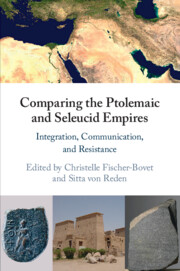Book contents
- Comparing the Ptolemaic and Seleucid Empires
- Comparing the Ptolemaic and Seleucid Empires
- Copyright page
- Contents
- Contributors
- Preface
- Note on Abbreviations
- Maps
- Introduction
- Part I Cities, Settlement and Integration
- Chapter 1 Imperial metropoleis and Foundation Myths
- Chapter 2 Reassessing Hellenistic Settlement Policies
- Chapter 3 The Integration of Indigenous Elites and the Development of poleis in the Ptolemaic and Seleucid Empires
- Chapter 4 Contextualizing a Ptolemaic Solution
- Part II Communication and Exchange
- Part III Collaboration, Crisis, and Resistance
- Bibliography
- Index
Chapter 4 - Contextualizing a Ptolemaic Solution
The Institution of the Ethnic politeuma*
from Part I - Cities, Settlement and Integration
Published online by Cambridge University Press: 17 September 2021
- Comparing the Ptolemaic and Seleucid Empires
- Comparing the Ptolemaic and Seleucid Empires
- Copyright page
- Contents
- Contributors
- Preface
- Note on Abbreviations
- Maps
- Introduction
- Part I Cities, Settlement and Integration
- Chapter 1 Imperial metropoleis and Foundation Myths
- Chapter 2 Reassessing Hellenistic Settlement Policies
- Chapter 3 The Integration of Indigenous Elites and the Development of poleis in the Ptolemaic and Seleucid Empires
- Chapter 4 Contextualizing a Ptolemaic Solution
- Part II Communication and Exchange
- Part III Collaboration, Crisis, and Resistance
- Bibliography
- Index
Summary
This chapter examines the question of precisely why politeumata are not found in other Hellenistic kingdoms. Sänger argues that they were a specific response to the internal and external conflicts faced by the Ptolemies in the second century BCE. By offering the opportunity of founding a politeuma, the kings tightened the loyalty of ethnic groups settling or settled in Egypt and attracted new immigrants. The core members of a politeuma belonged to the army as mercenaries and would identify to a given ethnic group. After their settlement, they formed an “ethnic community” sharing a temple and a quarter of the urban space. Sänger suggests, furthermore, that since poleis in the Greek constitutional sense played a limited role in Egypt (see other chapters in the same volume), constitutional terms connected to the Greek polis were applied freely and allowed derivatives such as the politeuma to develop. The apparent specificity of Ptolemaic politeumata emerges as just a particular case of binding soldiers to urban spaces and attracting them as identity groups. These show altered ruling strategies when compared with the Ptolemaic cleruchies and army organization of the third century BCE.
Keywords
- Type
- Chapter
- Information
- Comparing the Ptolemaic and Seleucid EmpiresIntegration, Communication, and Resistance, pp. 106 - 126Publisher: Cambridge University PressPrint publication year: 2021

